Anna University
Engineering Physics 2
Unit 5
Variation of Fermi level with temperature and carrier concentration
INTRODUCTION – Smart Memory Alloy (SMA)
Shape Memory Alloys (SMAs) are metals that "remember" their original shapes. SMAs are useful for such things as actuators which are materials that "change shape, stiffness, position, natural frequency, and other mechanical characteristics in response to temperature or electromagnetic fields" (Rogers, 155). The potential uses for SMAs especially as actuators have broadened the spectrum of many scientific fields. The study of the history and development of SMAs can provide an insight into a material involved in cutting-edge technology. The diverse applications for these metals have made them increasingly important and visible to the world.
Learning Objectives
On completion of this topic you will be able to answer for the questions like:
1. Describe Shape Memory Alloys (SMAs) by drawing a neat diagram for austenite and martensite.
2. Explain shape memory effect (SME) and what are the types of SME?
3. Discuss thermal and magnetic shape memory effect with essential diagrams.
4. What are the applications of SMAs?
THERMAL SHAPE MEMORY EFFECT
Shape Memory Alloys (SMAs) are a unique class of metal alloys that can recover apparent permanent strains when they are heated above a certain temperature. The SMAs have two stable phases - the high-temperature phase, called austenite and the low-temperature phase, called martensite. In addition, the martensite can be in one of two forms: twinned and detwinned, as shown in Figure 1. A phase transformation which occurs between these two phases upon heating/cooling is the basis for the unique properties of the SMAs. The key effects of SMAs associated with the phase transformation are pseudoelasticity and shape memory effect.
Figure 1. Different phases of an SMA.
Upon cooling in the absence of applied load the material transforms from austenite into twinned (self-accommodated) martensite. As a result of this phase transformation no observable macroscopic shape change occurs. Upon heating the material in the martensitic phase, a reverse phase transformation takes place and as a result the material transforms to austenite.
The above process is shown in Figure 2. Four characteristic temperatures are defined in Figure 2: martensitic start temperature (M0s) which is the temperature at which the material starts transforming from austenite o martensite; martensitic finish temperature (M0f), at which the transformation is complete and the material is fully in the martensitic phase; austenite start temperature (Aos) at which the reverse transformation (austenite to martensite) initiates; and austenite finish temperature (Aof) at which the reverse phase transformation is completed and the material is the austenitic phase.
Figure 2. Temperature-induced phase transformation of an SMA without mechanical loading.
Thermally-Induced Transformation with Applied Mechanical Load:
If mechanical load is applied to the material in the state of twinned martensite (at low temperature) it is possible to detwin the martensite. Upon releasing of the load, the material remains deformed. A subsequent heating of the material to a temperature above A0f will result in reverse phase transformation (martensite to austenite) and will lead to complete shape recovery, as shown in Figure 3. The above described process results in manifestation of the Shape Memory Effect (SME).
Figure 3. Shape Memory Effect of an SMA.
It is also possible to induce a martensitic transformation which would lead directly to detwinned martensite. If load is applied in the austenitic phase and the material is cooled, the phase transformation will result in detwinned martensite. Thus, very large strains (on the order of 5-8%) will be observed. Reheating the material will result in complete shape recovery. The above-described loading path is shown in Figure 4.
Figure 4. Temperature-induced phase transformation with applied load.
The transformation temperatures in this case strongly depend on the magnitude of the applied load. Higher values of the applied load will lead to higher values of the transformation temperatures. Usually a linear relationship between the applied load and the transformation temperatures is assumed, as shown in Figure 4.
Generally, the so called “shape memory effect” implies an irreversible, one way phenomenon-unless “reversible” or “two-way effects” are specifically mentioned. When an alloy in which some fixed shape has been stored is deformed at low temperatures and then subsequently heated above the transformation temperature, it reverts to the original shape. Even if the specimen is cooled again, it will not return to the shape it had when deformed at low temperatures. In order to store a low- temperature shape in the alloy, and induce two-way characteristics which enable reversible operations to be repeated according to rises and falls in the temperature, sophisticated techniques are necessary.
There are two methods for achieving two-way operation properties:
1) a method in which special processing is performed to give the alloy itself two-way characteristics, and
2) a method in which an alloy with one-way characteristics is combined with springs, weights, or other parts so that the component as a whole has two way characteristics.
Figure 5. Temperature-induced phase transformation with applied load.
MAGNETIC SHAPE MEMORY EFFECT
Magnetic shape memory (MSM) alloys are smart materials which can undergo large reversible deformations in an applied magnetic field. As such, they can function both as sensors and as actuators. Compared to the ordinary (temperature driven) shape memory alloys the magnetic control offers faster response, as the heating and especially cooling is slower than applying the magnetic field. Also, the maximum deformation obtained from MSM alloys is larger than in the ordinary magnetostrictive materials. At the moment, the largest magnetic field induced deformations have been observed in Ni-Mn-Ga alloys close to the stoichiometric composition Ni2MnGa, where strains up to 6 % are obtained in the field of 0.6 T. The video clip shows a piece of Ni2MnGa in a changing magnetic field.
When Ni2MnGa is cooled down it undergoes a structural (so called martensitic) transformation from a cubic to a tetragonal structure. There are three equivalent directions for the tetragonal distortions, which results in a twinned microstructure: there are regions called twin variants which have the same structure but whose tetragonal distortion has occured in different directions. The twin variants are separated by well defined boundaries. The ordinary shape memory effect is based on the relatively easy movement of the twin boundaries (resulting in large shape changes) and the recovery of the original structure when heated above the structural transition temperature. Below is a schematic view of the martensitic transformation and the resulting twinned microstructure.
In the magnetic shape memory alloys there are also internal magnetic moments. In the absence of an external field the magnetic moments are aligned with the easy directions of the magnetization which differ in the different twins. When the external field is applied, the magnetic moments try to align with the field. There are two possibilities: the magnetic moments can just rotate within the twins or, as happens in the MSM effect, the twins themselves move so that the directions of the easy magnetizations align with the field. This latter mechanism, magnetic field induced redistribution of the twin variants gives the large shape changes observed in the MSM alloys.
SOME COMMON SHAPE MEMORY ALLOYS AND THEIR PHYSICAL PROPERTIES
MANUFATURING OF SMA
Shape memory alloys are typically made by casting, using vacuum arc melting or induction melting. These are specialist techniques used to keep impurities in the alloy to a minimum and ensure the metals are well mixed. The ingot is then hot rolled into longer sections and then drawn to turn it into wire.
The way in which the alloys are "trained" depends on the properties wanted. The "training" dictates the shape that the alloy will remember when it is heated. This occurs by heating the alloy so that the dislocations re-order into stable positions, but not so hot that the material re-crystallizes. They are heated to between 400 °C and 500 °C for 30 minutes. Typical variables for some alloys are 500 °C and for more than 5 minutes.
They are then shaped while hot and are cooled rapidly by quenching in water or by cooling with air.
APPLICATIONS OF SMA
Industrial
Aircraft:
Boeing, General Electric Aircraft Engines, Goodrich Corporation, NASA, and All Nippon Airways developed the Variable Geometry Chevron using shape memory alloy that reduces aircraft's engine noise. All of [Boeing's] new aircraft will be equipped with this new technology.
Piping:
The first consumer commercial application for the material was as a shape memory coupling for piping, e.g. oil line pipes for industrial applications, water pipes and similar types of piping for consumer/commercial applications. The late 1980s saw the commercial introduction of Nitinol as an enabling technology in a number of minimally invasive endovascular medical applications. While more costly than stainless steel, the self expanding properties of Nitinol alloys manufactured to BTR (Body Temperature Response), have provided an attractive alternative to balloon expandable devices. On average, 50% of all peripheral vascular stents currently available on the worldwide market are manufactured with Nitinol.
Robotics:
There have also been limited studies on using these materials in robotics (such as "Roboterfrau Lara"), as they make it possible to create very light robots. Weak points of the technology are energy inefficiency, slow response times, and large hysteresis.
Nitinol wire is also used in robotics (e.g. the hobbyist robot Stiquito) and in a few magic tricks, particularly those involving heat and shapeshifting.
Medicine
Optometry:
Eyeglass frames made from titanium-containing SMAs are marketed under the trademarks Flexon and TITANflex.
Dentistry:
The range of applications for SMAs has grown over the years, a major area of development being medicine. One example is the prevalence of dental braces using SMA technology to exert constant tooth-moving forces on the teeth; the nitinol archwire was developed in 1972 by orthodontist George Andreasen. This revolutionized clinical orthodontics and has also had an affect on fiber optic development. Andreasen's alloy has a patterned shape memory, expanding and contracting within given temperature ranges because of its geometric programming.
Check your understanding
1. Give three examples for SMAs.
Ans : Ni-Ti, Cu-Zn-Al and Cu-Al-Ni
2. Draw the typical transformation hysteresis curve SMA representing Mf, Ms, As and Af.
Ans :
Summary
On completion of this material, you have learned:
• SMAs have two stable phases - the high-temperature phase, called austenite and the low-temperature phase, called martensite.
• the martensite can be in one of two forms: twinned and detwinned.
• A phase transformation which occurs between these two phases upon heating/cooling is the basis for the unique properties of the SMAs.
Activity
Try to collect a lot of examples for the applications of SMA.
Suggested Reading (in addition to some internet resources)
1. S.O. Pillai, ‘Solid State Physics’, New Age International Publishers, New Delhi (2006).
2. Palanisamy P.K, ‘Engineering Physics – II’, Scitech Publications (India) Pvt. Ltd., Chennai (2008).

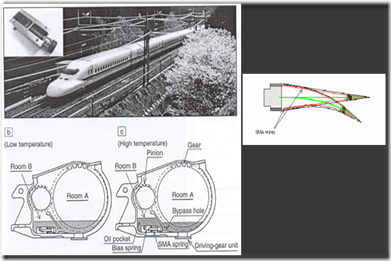

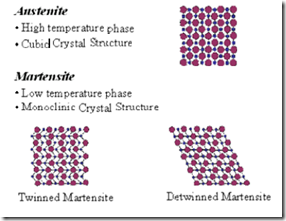

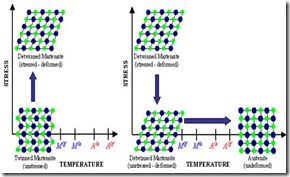
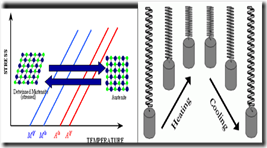
![clip_image001[14] clip_image001[14]](http://lh6.ggpht.com/-drJW-9lz6Vo/T4D2lB3ZgAI/AAAAAAAACQE/JFvH2T3l5EA/clip_image001%25255B14%25255D_thumb%25255B1%25255D.png?imgmax=800)
![clip_image001[16] clip_image001[16]](http://lh5.ggpht.com/-SW4yky3O4kE/T4D2r6T1BqI/AAAAAAAACQY/Gc131JJeOuc/clip_image001%25255B16%25255D_thumb%25255B1%25255D.png?imgmax=800)
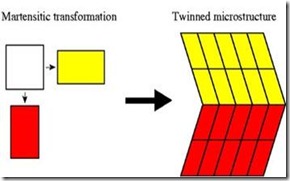
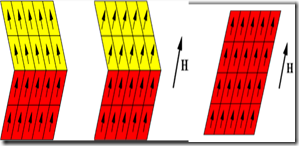
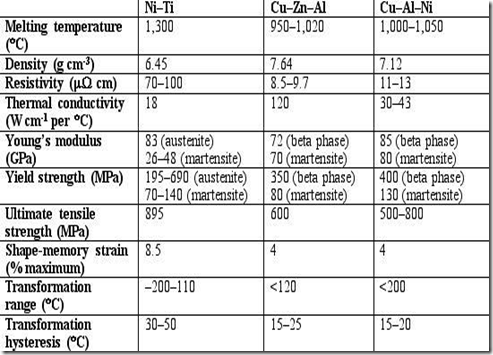
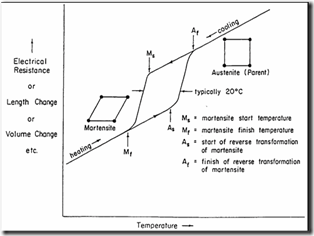





Such an absorbing piece! It feels like a journey through the labyrinth of human thought, skillfully articulated. The writer's perspective is intriguing, encouraging introspection about the nuances of existence. I'm excited for more articles that provoke contemplation and encourage connection in our shared human tapestry.
ReplyDelete